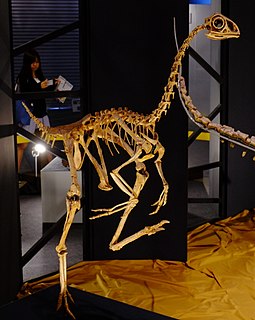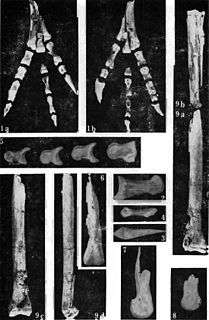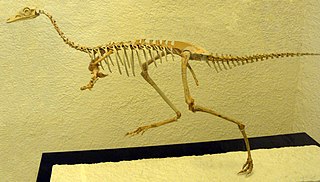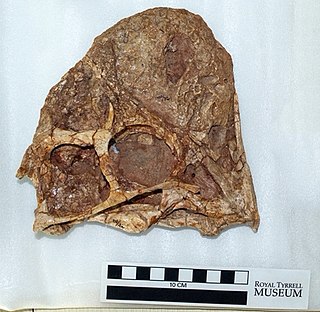 W
WAdasaurus is a genus of dromaeosaurid dinosaur that lived in Asia during the Late Cretaceous period about 70 million years ago. The genus is known from two partial specimens found in the Nemegt Formation of Mongolia that were partially described in 1983 by the paleontologist Rinchen Barsbold.
 W
WAlioramus is a genus of tyrannosaurid theropod dinosaurs from the Late Cretaceous period of Asia. The type species, It currently contains two species. A. remotus is known from a partial skull and three foot bones recovered from the Mongolian Nemegt Formation, which was deposited in a humid floodplain about 70 million years ago. These remains were named and described by Soviet paleontologist Sergei Kurzanov in 1976. A second species, A. altai, known from a much more complete skeleton, was named and described by Stephen L. Brusatte and colleagues in 2009. Its relationships to other tyrannosaurid genera are unclear, with some evidence supporting a hypothesis that Alioramus is closely related to the contemporary species Tarbosaurus bataar.
 W
WAnserimimus is a genus of ornithomimid theropod dinosaur, from the Late Cretaceous Period of what is now Mongolia. It was a lanky, fast-running animal, possibly an omnivore. From what fossils are known, it probably closely resembled other ornithomimids, except for its more powerful forelimbs.
 W
WAvimimus, meaning "bird mimic", is a genus of oviraptorosaurian theropod dinosaur, named for its bird-like characteristics, that lived in the late Cretaceous in what is now Mongolia, around 85 to 70 million years ago.
 W
WBagaraatan is a genus of theropod dinosaur from the Late Cretaceous period. Its fossils were found in the Nemegt Formation of Mongolia. Bagaraatan may have been around 3 to 4 metres in length.
 W
WBarsboldia was a genus of large hadrosaurid dinosaur from the early Maastrichtian Nemegt Formation of Ömnogöv', Mongolia. It is known from a partial vertebral column, partial pelvis, and some ribs.
 W
WBorogovia is a troodontid theropod dinosaur genus which lived during the Late Cretaceous Period, in what is now Mongolia.
 W
WConchoraptor is a genus of oviraptorid dinosaur from the late Cretaceous Period of what is now Asia.
 W
WDeinocheirus is a genus of large ornithomimosaur that lived during the Late Cretaceous around 70 million years ago. In 1965, a pair of large arms, shoulder girdles, and a few other bones of a new dinosaur were first discovered in the Nemegt Formation of Mongolia. In 1970, this specimen became the holotype of the only species within the genus, Deinocheirus mirificus; the genus name is Greek for "horrible hand". No further remains were discovered for almost fifty years, and its nature remained a mystery. Two more complete specimens were described in 2014, which shed light on many aspects of the animal. Parts of these new specimens had been looted from Mongolia some years before, but were repatriated in 2014.
 W
WElmisaurus is an extinct genus of dinosaur from the Late Cretaceous. It was a theropod belonging to the Oviraptorosauria. Its fossils have been found in Mongolia. It is known from foot and hand bones.
 W
WGallimimus is a genus of theropod dinosaur that lived in what is now Mongolia during the Late Cretaceous period, about seventy million years ago (mya). Several fossils in various stages of growth were discovered by Polish-Mongolian expeditions in the Gobi Desert of Mongolia during the 1960s; a large skeleton discovered in this region was made the holotype specimen of the new genus and species Gallimimus bullatus in 1972. The generic name means "chicken mimic", referring to the similarities between its neck vertebrae and those of the Galliformes. The specific name is derived from bulla, a gold capsule worn by Roman youth, in reference to a bulbous structure at the base of the skull of Gallimimus. At the time it was named, the fossils of Gallimimus represented the most complete and best preserved ornithomimid material yet discovered, and the genus remains one of the best known members of the group.
 W
WGobiraptor is a genus of oviraptorid maniraptoran dinosaur from the Maastrichtian-age Nemegt Formation of Mongolia. The type and only species is Gobiraptor minutus, known from a single incomplete specimen—the holotype MPC-D 102/111. It has been found not to be closely related to the other oviraptorids it shared its environment with.
 W
WMononykus is a genus of alvarezsaurid dinosaur that lived during the Late Cretaceous in what is now Asia on the Nemegt Formation, about 70 million years ago.
 W
WNemegtomaia is a genus of oviraptorid dinosaur from what is now Mongolia that lived in the Late Cretaceous Period, about 70 million years ago. The first specimen was found in 1996, and became the basis of the new genus and species N. barsboldi in 2004. The original genus name was Nemegtia, but this was changed to Nemegtomaia in 2005, as the former name was preoccupied. The first part of the generic name refers to the Nemegt Basin, where the animal was found, and the second part means "good mother", in reference to the fact that oviraptorids are known to have brooded their eggs. The specific name honours the palaeontologist Rinchen Barsbold. Two more specimens were found in 2007, one of which was found on top of a nest with eggs, but the dinosaur had received its genus name before it was found associated with eggs.
 W
WNemegtonykus is a genus of alvarezsaurid dinosaur from the Nemegt Formation in Mongolia. The type and only species is Nemegtonykus citus. It is only the second alvarezsaur known from the Nemegt Formation, the other being Mononykus.
 W
WNemegtosaurus was a sauropod dinosaur from Late Cretaceous Period of what is now Mongolia. Nemegtosaurus was named after the Nemegt Basin in the Gobi Desert, where the remains — a single skull — were found. The skull resembles diplodocoids in being long and low, with pencil-shaped teeth. However, recent work has shown that Nemegtosaurus is in fact a titanosaur, closely related to animals such as Saltasaurus, Alamosaurus and Rapetosaurus.
 W
WNomingia is a genus of oviraptorid theropod dinosaur hailing from the Late Cretaceous Bugin Tsav Beds of Mongolia.
 W
WOksoko is a genus of oviraptorid dinosaur from the Late Cretaceous of Asia, that lived in what is now the Nemegt Formation in Mongolia. It includes the type species Oksoko avarsan.
 W
WOpisthocoelicaudia is a genus of sauropod dinosaur of the Late Cretaceous Period discovered in the Gobi Desert of Mongolia. The type species is Opisthocoelicaudia skarzynskii. A well-preserved skeleton lacking only the head and neck was unearthed in 1965 by Polish and Mongolian scientists, making Opisthocoelicaudia one of the best known sauropods from the Late Cretaceous. Tooth marks on this skeleton indicate that large carnivorous dinosaurs had fed on the carcass and possibly had carried away the now-missing parts. To date, only two additional, much less complete specimens are known, including part of a shoulder and a fragmentary tail. A relatively small sauropod, Opisthocoelicaudia measured about 11.4–13 m (37–43 ft) in length. Like other sauropods, it would have been characterised by a small head sitting on a very long neck and a barrel shaped trunk carried by four column-like legs. The name Opisthocoelicaudia means "posterior cavity tail", alluding to the unusual, opisthocoel condition of the anterior tail vertebrae that were concave on their posterior sides. This and other skeletal features lead researchers to propose that Opisthocoelicaudia was able to rear on its hindlegs.
 W
WPrenocephale was a small pachycephalosaurid dinosaur genus from the Late Cretaceous (Campanian) of Mongolia and was similar in many ways to its close relative, Homalocephale, which may simply represent Prenocephale juveniles.
 W
WRaptorex is a dubious genus of tyrannosaurid dinosaur. Its fossil remains consist of a single juvenile specimen probably uncovered in Mongolia, or possibly northeastern China. The type species is R. kriegsteini, described in 2009 by Sereno and colleagues. The genus name is derived from Latin raptor, "robber", and rex, "king". The specific name honours Roman Kriegstein, a survivor of the Holocaust, whose son Henry Kriegstein donated the specimen to the University of Chicago for scientific study.
 W
WRinchenia is a genus of oviraptorid dinosaur from the Late Cretaceous Nemegt Formation of Mongolia. The type species, Rinchenia mongoliensis, was originally classified as a species within the genus Oviraptor, but a re-examination by Barsbold in 1997 found differences significant enough to warrant a separate genus. The name Rinchenia was coined for this new genus by Barsbold in 1997, though he did not describe it in detail, and the name remained a nomen nudum until used by Osmólska et al. in 2004.
 W
WSaichania is a genus of herbivorous ankylosaurid dinosaur from the Late Cretaceous period of Mongolia and China.
 W
WTarbosaurus is a genus of tyrannosaurid theropod dinosaur that flourished in Asia about 70 million years ago, at the end of the Late Cretaceous Period, considered to contain a single known species, Tarbosaurus bataar. Fossils have been recovered in Mongolia, with more fragmentary remains found further afield in parts of China.
 W
WTherizinosaurus is a genus of very large therizinosaurid that lived in Asia during the Late Cretaceous period in what is now the Nemegt Formation around 70 million years ago. The first remains of Therizinosaurus were found in 1948 by a Mongolian field expedition at the Gobi Desert. Fossils of this species were first described by Evgeny Maleev in 1954 and originally thought to belong to a turtle-like reptile. The genus is known only from a few bones, including gigantic hand claws, from which it gets its name, and additional findings comprising forelimb and hindlimb elements that have been discovered during the 1960s-1980s.
 W
WTochisaurus is a genus of small troodontid theropod dinosaur from the Late Cretaceous Period of Mongolia. The type species is Tochisaurus nemegtensis.
 W
WZanabazar is a genus of large troodontid dinosaurs from the Late Cretaceous of Mongolia. The genus was originally named by Rinchen Barsbold as the new species Saurornithoides junior. In 2009 it was reclassified as its own genus and species, Zanabazar junior, named after the first spiritual figurehead of Tibetan buddhism, Zanabazar. The holotype includes a skull, vertebrae, and right hindlimb. Zanabazar was one of the largest and most derived troodontids.